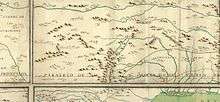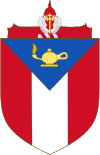Texas Memorial Museum

The Texas Memorial Museum, which is located on the campus of the University of Texas at Austin in Austin, Texas, USA, is named in honor of the 1936 Texas Centennial. The museum's focus is on natural history, including paleontology, geology, biology, herpetology, ichthyology and entomology. At one point, the museum also had exhibits on Texas history, anthropology, geography, and ethnography, but these were relocated to other museums (including the Bullock Texas State History Museum) in 2001. The museum has 75,000 visitors annually.
The building was designed in the Art Deco style by John F. Staub, with Paul Cret as supervising architect. Ground was broken for the building by President Franklin D. Roosevelt in January 1936.[1] The museum was opened on January 15, 1939.
The museum won "Best of Austin" awards from the Austin Chronicle in 2002 and 2005.[2]
In October 2013, it was announced that the museum would be losing $400,000 in funding, ownership would be transferred to the American Legion Texas Branch, and that the staff would be reduced from twelve employees to four: the museum director, a science director, a webmaster, and a private security officer.[3] The museum now is open five days a week and charges admission.
Wichita County Meteorite


In 1723, the Comanche defeated the Lipan Apache people in a nine-day battle along the Rio del Fierro (Wichita River).[5][6] The River of Iron may be the location written about by Athanase De Mezieres in 1772, containing "a mass of metal which the Indians say is hard, thick, heavy, and composed of iron", which they "venerate...as an extraordinary manifestation of nature", the Comanche's calling it "Ta-pic-ta-carre [standing rock], Po-i-wisht-carre [standing metal], or Po-a-cat-le-pi-le-carre [medicine rock]", the general area containing a "large number of meteoric masses".[7][8]
"According to the Indians, the mass was first discovered by the Spaniards, who made several ineffectual attempts to remove it on pack mules but were finally compelled to abandon it on account of its great weight. The Comanches at first endeavored to melt the mass by building large fires around it, but failing in this, they next attempted to break it in pieces, in which they were likewise unsuccessful; they then conceived the idea that it was a wonderful medicine stone and therefore worthy of their most profound regard...it was the custom of all who passed by to deposit upon it beads, arrowheads, tobacco, and other articles as offerings."[9]
The Wichita County meteorite originally weighed 145 kg and was obtained by Major Robert Neighbors,[10] US Indian agent at Fort Belknap, in 1858-1859, who presented it to the State Cabinet, and was displayed in the old Capitol building before it burned down, when this Coarse Octahedrite was turned over to the University of Texas.[11] According to Neighbors, "When the meteorite was conveyed to the Indian reserve, the Comanches collected in great numbers around their valued medicine stone and, whilst manifesting their attachment by rubbing their arms, hands, and chests over it, earnestly besought Major Neighbors to permit them to keep it at the agency."[12]
A sister meteorite weighing 742 kg, the Red River meteorite, was discovered in 1808[13] but this Medium Octahedrite now resides in the Yale Peabody Museum of Natural History.[14]
References
- ↑ UT Austin - VRC - Highlights
- ↑ Awards Received - Texas Memorial Museum
- ↑ http://www.dailytexanonline.com/news/2013/10/28/on-campus-museum-set-to-lose-400000-in-funding
- ↑ Urrutia, Lafora and Ruby, 1769, Map of Frontier, US Library of Congress
- ↑ Dunn, W. E., 1911, Apache Relations in Texas, 1718-1750, in the Texas Historical Association Quarterly, Vol. 14, No. 3, p. 220
- ↑ Bolton, H. E., 1914, Athanase de Menzieres and the Louisiana-Texas Frontier, 1768-1780, Volume 1, Cleveland: The Arthur H. Clark Company, pp. 24-25
- ↑ Bolton, H. E., 1914, Athanase de Menzieres and the Louisiana-Texas Frontier, 1768-1780, Volume 1, Cleveland: The Arthur H. Clark Company, p. 296
- ↑ Farrington, O.C., 1909, Meteorites of North America, to January 1, 1909, National Academy of Sciences Volume XIII, p. 486
- ↑ Farrington, O.C., 1909, Meteorites of North America, to January 1, 1909, National Academy of Sciences Volume XIII, p. 486
- ↑ Neighbors, K.F., 1975, Robert Neighbors and the Texas Frontier, 1836-1859, Waco: Texian Press, p. 65 and 172
- ↑ Farrington, O.C., 1909, Meteorites of North America, to January 1, 1909, National Academy of Sciences Volume XIII, p. 487
- ↑ Farrington, O.C., 1909, Meteorites of North America, to January 1, 1909, National Academy of Sciences Volume XIII, p. 486
- ↑ Farrington, O.C., 1909, Meteorites of North America, to January 1, 1909, National Academy of Sciences Volume XIII, p. 488
- ↑ Farrington, O.C., 1909, Meteorites of North America, to January 1, 1909, National Academy of Sciences Volume XIII, p. 488
External links
| Wikimedia Commons has media related to Texas Memorial Museum. |
Coordinates: 30°17′13″N 97°43′57″W / 30.2870°N 97.7324°W

